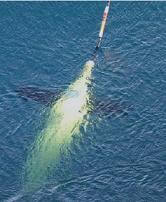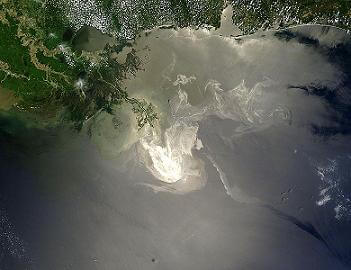Underwater Drones from iRobot Helping Monitor Gulf Oil Spill

Share
Researchers are employing iRobot's Seaglider unmanned underwater vehicle (UUV) to monitor the damage caused in the Gulf of Mexico by the Deepwater Horizon Oil Spill. The six foot long autonomous robots are capable of operating for 10 months on their own, monitoring water conditions down to 1 km (~3300 feet). They periodically resurface to transmit data via satellite. Current Seagliders in the Gulf are tracking temperture, salinity, dissolved oxygen, and presence of organic compounds (oil). Data analysis and technical support is being handled by Vernon Asper of the University of Southern Mississippi and Craig Lee of the University of Washington. Seaglider data may prove to be a valuable asset in dealing with the ongoing environmental crisis in the Gulf.
The scale of the Deepwater Horizon Oil Spill is monumental. Millions of barrels of oil have already been released into the Gulf of Mexico habitat, and more continues to leak from secondary holes in the system. While no one is able to predict the environmental impact this disaster will have on the region, there's a nearly universal agreement among experts that it will have a serious and negative impact on marine wildlife, fishing economies, and coastal wetlands. In order to respond to the crisis, scientists and leaders need up to date information about where oil is headed, and in what quantities, in order to coordinate countermeasure and relief efforts.
Robotic explorers like the Seaglider have become indispensable tools for marine science. We've seen remote submersibles in use at Rutgers University, and underwater drones from UC San Diego will soon track huge regions of our oceans. Over 120 of iRobot's Seagliders are already in the field for use with various research groups around the world. While under commercial license with iRobot, the Seaglider was originally designed by the University of Washington. Their, the UUV has already made several important excursions, including long range surveys under the Artic ice shelf. Craig Lee explains that mission, and the use of the Seaglider, in this video from last year:
Be Part of the Future
Sign up to receive top stories about groundbreaking technologies and visionary thinkers from SingularityHub.


The Seaglider can last so long underwater (up to 10 months) because it doesn't rely on traditional propeller systems. Instead, it 'glides' through different ocean strata using changes in buoyancy. It also collects data as it moves through these different levels, allowing it to provide valuable insight into what's happening far below the surface of the water. A few times a day, the UUV surfaces and uses a meter long antenna to transmit data and receive instructions.
Being able to send an autonomous drone to measure variables at different depths is of great use in this recent oil spill. Deepwater Horizon has released oil droplets throughout the Gulf, and the Seaglider has detected clouds of this crude as far down as 700 meters. Researchers like Asper and Lee can use an internet-based interface to control the Seaglider and direct it to different locations and depths as needed to get a a better picture of how the crude oil is dispersing. Meanwhile measurements of temperature, dissolved oxygen, and salinity give the scientists some idea of how marine life would fair in the region even without direct measurement of a species.
It will likely be many years before we fully understand the economic and environmental impact of the Deepwater Horizon Oil Spill, but much needs to be done in the short term to stem the devastation it could cause. To that end, the Seaglider robot is a great technology to assist in the response effort. More information is always good in situations like this. In the future, advanced technologies will become an increasingly visible part of disaster relief and recovery, not only helping to collect valuable data, but also direct civilian response. Moving forward I hope that we use accelerating technology to not only react to ongoing crises, but help prevent them. With a little intelligence (artificial or otherwise) many of these disasters could be avoided.
[image credit: iRobot, NASA via WikiCommons]
[video credit: NSF/University of Washington]
[source: iRobot, Bloomberg Business Week]
Related Articles

These Robots Are the Size of Single Cells and Cost Just a Penny Apiece

In Wild Experiment, Surgeon Uses Robot to Remove Blood Clot in Brain 4,000 Miles Away

A Squishy New Robotic ‘Eye’ Automatically Focuses Like Our Own
What we’re reading

